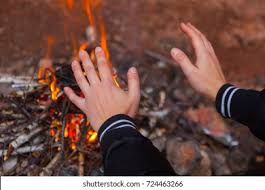FIRE - WARM!
- shredder

- Feb 19, 2021
- 3 min read

Fire is warm. In order to build an effective fire it probably helps to understand the basic principles of fire. Understanding the concepts of the fire "triangle" will help in the construction and maintenance of a fire. First we need fuel...in a solid, non-gaseous state. Fuel in this state does not burn directly but when you apply heat to a fuel it produces a gas. This gas, when combine with oxygen will burn when exposed to heat or a flame.
The three sides of the triangle are air, heat, and fuel. Remove any of these and the fire will not be maintained. However, get these three together properly and in the correct mixture and you will have a fire that burns with the greatest efficiency and thereby will be the most effective at providing the WARMTH you desire
PRACTICE, PRACTICE, PRACTICE Of course, fire can be used for more than just warmth. food preparation, tool making, etc are all benefited from the flame, but WARMTH! Lets start with PREPARATION Sight Selection and preparation matter -what is the terrain or environment you are operating in? -what materials and tools are available
-how much time do you have
-security (do you need the fire to be less visible -find a dry, flat spot to build your fire
- consider wind protection
-consider location/proximity to a shelter (if any)
-can you concentrate/direct/reflect the heat from the fire
-do you have a sustainable fuel source
If you are in a wooded or brush covered area, clear the brush and level the spot by scraping the soil. Clear an area at least 1 meter (3 feet) in diameter. this will help to prevent your fire from spreading.
If time allows, build a fire wall in order to assist in reflecting/directing/radiating the heat from your fire towards you and your shelter (if used). Be sure not to block your oxygen source completely. the wall should minimize the wind, but still allow for air flow


In some situations you may find that building your fire underground will better meet your needs. an underground fire will not provide the same general WARMTH you might be looking for, but can help in the concealment of your fire and also help to concentrate the heat from your fire to better suit food preparation. A small fire wall can help with the general WARMTH issue. A Dakota Fire Hole/Pit does the trick perfectly Key Considerations: -Dig your fire hole Fire hole 10-12" deep (the diameter of the whole should be about 8-10") -Dig an airflow whole at least 8-10" from the fire hole and 10-12" deep (this hole also acts as a fuel feeder line). ensure the wind direction flows into the airflow hole
-connect the two holes.
-Build a fire in the fire hole, blowing air into the airflow hole (feed fuel into the fire as needed)


Perhaps you are in a snow covered or swampy area...or perhaps the ground is just wet and soggy. in this case you will want to first build a base for your fire. -Find "green" Sticks and/or logs. Green Tree branches break easily in the extreme cold. cut branches and logs if needed. -lay the logs on the ground side by side aligned in the same direction. This is your "base layer"
-layer another layer of logs on top of the base layer. Ensure they are laid side by side and in the opposite direction of the base layer. -continue this method of construction until you are safely elevated above the snow or soggy ground


TO BE CONTINUED.....







#SuddenDarkness